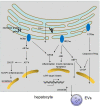Hepatocytes: A key role in liver inflammation
- PMID: 36741394
- PMCID: PMC9890163
- DOI: 10.3389/fimmu.2022.1083780
Hepatocytes: A key role in liver inflammation
Abstract
Hepatocytes, the major parenchymal cells in the liver, are responsible for a variety of cellular functions including carbohydrate, lipid and protein metabolism, detoxification and immune cell activation to maintain liver homeotasis. Recent studies show hepatocytes play a pivotal role in liver inflammation. After receiving liver insults and inflammatory signals, hepatocytes may undergo organelle damage, and further respond by releasing mediators and expressing molecules that can act in the microenvironment as well as initiate a robust inflammatory response. In this review, we summarize how the hepatic organelle damage link to liver inflammation and introduce numerous hepatocyte-derived pro-inflammatory factors in response to chronic liver injury.
Keywords: cytokines; extracellular vesicles; hepatic inflammation; hepatocyte; organelle damage.
Copyright © 2023 Gong, Tu, Liu and Tian.
Conflict of interest statement
The authors declare that the research was conducted in the absence of any commercial or financial relationships that could be construed as a potential conflict of interest.
Figures


References
Publication types
MeSH terms
LinkOut - more resources
Full Text Sources
Medical

